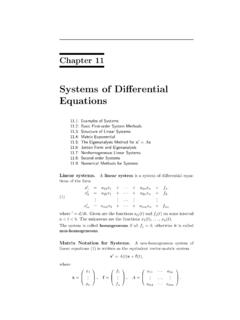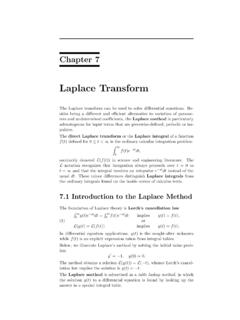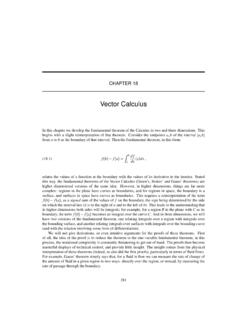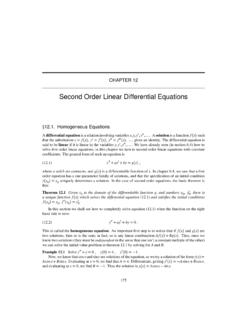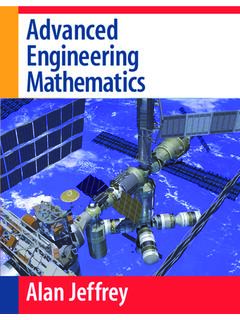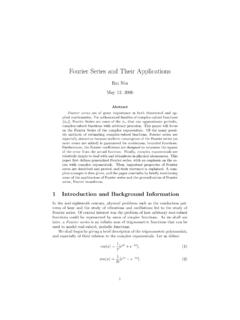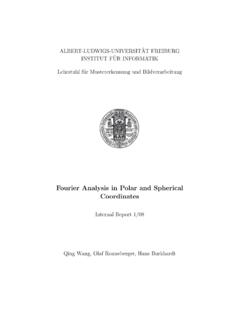Transcription of Fourier Series - Math
1 Fourier Series Fourier Sine Series Fourier Cosine Series Fourier Series Convergence of Fourier Series for2T-Periodic Functions Convergence of Half-Range Expansions: Cosine Series Convergence of Half-Range Expansions: Sine Series Sawtooth Wave Triangular Wave Parseval s Identity and Bessel s Inequality Complex Fourier Series Dirichlet Kernel and ConvergenceFourier Sine SeriesDefinition. Consider the orthogonal system{sin(n xT)} n=1on[ T,T]. A Fouriersine Series with coefficients{bn} n=1is the expressionF(x) = n=1bnsin(n xT)Theorem. A Fourier sine seriesF(x)is an odd2T-periodic The coefficients{bn} n=1in a Fourier sine seriesF(x)are determined by theformulas (inner product on[ T,T])bn= F,sin(n xT) sin(n xT),sin(n xT) =2T T0F(x) sin(n xT) Cosine SeriesDefinition. Consider the orthogonal system{cos(m xT)} m=0on[ T,T]. A Fouriercosine Series with coefficients{am} m=0is the expressionF(x) = m=0amcos(m xT)Theorem. A Fourier cosine seriesF(x)is an even2T-periodic The coefficients{am} m=0in a Fourier cosine seriesF(x)are determined bythe formulas (inner product on[ T,T])am= F,cos(m xT) cos(m xT),cos(m xT) = 2T T0F(x) cos(m xT)dx m >0,1T T0F(x)dxm= SeriesDefinition.
2 Consider the orthogonal system{cos(m xT)} m=0,{sin(n xT)} n=1, on[ T,T]. A Fourier Series with coefficients{am} m=0,{bn} n=1is the expressionF(x) = m=0amcos(m xT)+ n=1bnsin(n xT)Theorem. A Fourier seriesF(x)is a2T-periodic The coefficients{am} m=0,{bn} n=1in a Fourier seriesF(x)are determinedby the formulas (inner product on[ T,T])am= F,cos(m xT) cos(m xT),cos(m xT) = 1T T TF(x) cos(m xT)dx m >0,12T T TF(x)dxm= F,sin(n xT) sin(n xT),sin(n xT) =1T T TF(x) sin(n xT) of Fourier Series for2T-Periodic FunctionsThe Fourier Series of a2T-periodic piecewise smooth functionf(x)isa0+ n=1(ancos(n xT)+bnsin(n xT))wherea0=12T T Tf(x)dx,an=1T T Tf(x) cos(n xT)dx,bn=1T T Tf(x) sin(n xT) Series converges tof(x)at points of continuity offand tof(x+)+f(x ) of Half-Range Expansions: Cosine SeriesThe Fourier cosine Series of a piecewise smooth functionf(x)on[0,T]is the even2T-periodic functiona0+ n=1ancos(n xT)wherea0=1T T0f(x)dx,an=2T T0f(x) cos(n xT) Series converges on0< x < Ttof(x)at points of continuity offand tof(x+)+f(x ) of Half-Range Expansions.
3 Sine SeriesThe Fourier sine Series of a piecewise smooth functionf(x)on[0,T]is the odd2T-periodic function n=1bnsin(n xT)wherebn=2T T0f(x) sin(n xT) Series converges on0< x < Ttof(x)at points of continuity offand tof(x+)+f(x ) WaveDefinition. Thesawtooth waveis the odd2 -periodic function defined on x by the formulasawtooth(x) = 12( x)0< x ,12( x) x <0,0x= The sawtooth wave has Fourier sine seriessawtooth(x) = n= WaveDefinition. Thetriangular waveis the even2 -periodic function defined on x by the formulatwave(x) ={ x0< x , +x x The triangular wave has Fourier cosine seriestwave(x) = 2+4 k=01(2k+ 1)2cos(2k+ 1) s Identity and Bessel s InequalityTheorem. (Bessel s Inequality)a20+12 n=1(a2n+b2n) 12T T T|f(x)|2dxTheorem. (Parseval s Identity)12T T T|f(x)|2dx=a20+12 n=1(a2n+b2n)Theorem. Parseval s identity for the sawtooth function implies 212=12 n=11n2 Complex Fourier SeriesDefinition. Letf(x)be2T-periodic and piecewise smooth.}
4 The complex Fourier seriesoffis n= cnein xT, cn=12T T Tf(x)e in xTdxTheorem. The complex Series converges tof(x)at points of continuity offand tof(x+)+f(x ) (Complex Parseval Identity)12T T T|f(x)|2dx= n= |cn|2 Dirichlet Kernel and ConvergenceTheorem. (Dirichlet Kernel Identity)12+ cosu+ cos 2u+ + cosnu=sin((n+12)u)2 sin(12u)Theorem. (Riemann-Lebesgue)For piecewise continuousg(x),limN g(x) sin(Nx)dx= : Integration theory implies it suffices to establish the result for smoothg. Integrate by parts toobtain1n(g( ) g( ))( 1)n+1n g(x) cos(nx)dx. Lettingn implies the Letf(x)be2 -periodic and smooth on the whole real line. Then the Fourierseries off(x)converges uniformly tof(x).Convergence ProofSTEP 1. LetsN(x)denote the Fourier Series partial sum. Using Dirichlet s kernel for-mula, we verify the identityf(x) sN(x) =1 x+ x (f(x) f(x+w))(sin((N+ 1/2)w)2 sin(w/2))dwSTEP 2. The integrandIis re-written asI=f(x) f(x+w)ww2 sin(w/2)sin((N+ 1/2)w).
5 STEP 3. The functiong(w) =f(x) f(x+w)wwsin(w/2)is piecewise continu-ous. Apply the Riemann-Lebesgue Theorem to complete the proof of the PhenomenaEngineering Interpretation: The graph off(x)and the graph ofa0+ Nn=1(ancosnx+bnsinnx)are identical to pixel resolution, providedNis sufficiently large. Computers can thereforegraphf(x)using a truncated Fourier (x)is only piecewise smooth, then pointwise convergence is still true, at points ofcontinuity off, but uniformity of the convergence fails near discontinuities offandf .Gibbs discovered the fixed-jump artifact, which appears at discontinuities off.

